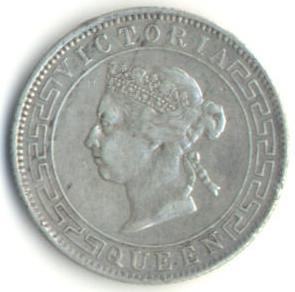
On 1869 June 18th the currency of Ceylon was regularized and an Order in Council and Proclamation which revoked previous orders and regulations. The Indian rupee with its silver sub-divisions was formally established as the sole legal tender for unlimited amount. For a copper coinage subsidiary to the silver, a decimal system was adopted and the rupee was valued at 100 cents. Copper coins, expressed in cents of the rupee, were specially struck for the Colony at the British Indian Government Mint, Calcutta, and were released into circulation on 1872 January 1st.
The weights of the Copper coins were based on Sterling coppers. One cent was approximately equal to one fathing at the then exchange rate of Rs 10 to a pound sterling. Note that these coins included the value in both Sinhala and Tamil for the first time since British colonization.
The 1871 August 23, Proclamation on Decimal Currency in Ceylon says From and after the First day of January, 1872, be lawfully current, and shall pass and be received as current and lawful tokens and payment within the Island of Ceylon and the Dependencies thereof, at and for the rates and values indicated thereon, and at no other rates or values. Provided, however, that no person shall be required to receive more than one half-Rupee in copper or bronze coins or tokens at one time.
In 1874, the last link between the old and the modern currency was broken when the old Ceylon coins were demonetized.
From 1872 until 1891, the Ceylon currency combined a binary with a decimal system for coins subordinate to the standard. Proposals were made by the Ceylon Government in 1890 for the demonetization of some of the Indian silver coins and their replacement by a local subsidiary silver currency. It was desired to retain the Indian rupee as the standard of value, but to replace the sub-divisions with a token silver subsidiary currency consisting of 50, 25 and 10 cents of a rupee.
Approval was given to this measure by an Order in Council dated 1892, February 9th and the new system came into force in Ceylon on the 1892 October 1st. Thus, apart from the Portuguese Indian rupee (demonetized after 1893 July 19th) and the British Indian 1/2 and 1/4 rupee, the coinage of Ceylon after 1892 consisted of:
The Coinage (Ceylon) Order, 1892. Adoption of Silver Coinage, states
Due to the fact that in the year 1892 the British Indian mints were precluded from striking silver coins of a fineness standard of less than 916.6 parts in 1000, the Ceylon silver token coinage was originally executed at the Royal Mint, London.
The obverse of the coin carries Young Head of Victoria to left. A fret border broken by the legend VICTORIA QUEEN Engraved by Leonard Charles Wyon of Royal Mint on the Silver and by William Wyon on the copper coins.
The reverse of the coin has in center a Talipot palm (coryply aumbraceulifera) also known as fan palm is a prominent palm species of Ceylon. The name CEYLON above and the year of issue below. The value in Sinhala and Tamil on either side. The sinhala text is to the right on the silver and to the left on the copper coins.

| ||||
| KM90 | Quarter | Cent | copper | coin |
| KM91 | Half | Cent | copper | coin |
| KM92 | One | Cent | copper | coin |
| KM93 | Five | Cent | copper | coin |
| KM94 | Ten | Cent | silver | coin |
| KM95 | TwentyFive | Cent | silver | coin |
| KM96 | Fifty | Cent | silver | coin |
It is interesting to note that Indian Silver and copper coins of minted after 1877 had VICTORIA EMPRESS, but the Ceylon coins which are dates after 1890 continued with the same 1870 designation VICTORIA QUEEN,
On the request of private individuals, provided the dies were available, the Indian mints did unusual "proof restrike" in silver and gold of the copper coins in this series on payment of prescribed fees and bullion charges. A number of these precious metal restrikes are listed in coin catalogs for many of the Victorian and Edward VII Ceylon coppers.
Text edited from
* The Coins of the British Commonwealth of Nations
F. Pridmore, London, Spink & Son Ltd., 1960.